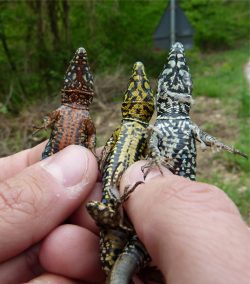How adaptive plasticity evolves when selected against
Yes, that is the surprise title of Alfredo’s new paper in PLoS Computation Biology! When we discover examples of adaptive plasticity we usually think that it evolved because selection favoured it. But can adaptive plasticity evolve when selection favours non-plastic individuals?
Think of a population of insects that hatches, reproduces and dies twice every year: once in spring and once in autumn. Spring and autumn conditions may be very different, but plasticity could allow the insects to cope with both seasons. Yet, insects born in spring never experience autumn, and vice versa, so natural selection cannot directly favour plasticity. In fact, plastic individuals may do worse than individuals that are not plastic, which means plasticity could consistently be selected against.
This problem is similar to tuning the learning rate in Machine Learning. To teach a machine how to solve a problem, we give it a set of example questions we already know the answer to. Each time the machine gives us the wrong answer, we change its parameters to produce a new answer that is closer to the right one. If the examples share a consistent logic, the machine will eventually find this logic. But if we change the model’s parameters too much with every example shown, the machine will just repeat the solution for the last example, which prevents it from finding the underlying logic that connects the examples.
Just like in machine learning, organisms receive a set of questions in the form of environmental cues and need to provide the right answer in terms of a fit phenotype. Adaptive plasticity is the solution that produces the right phenotype for every environment. Organisms that see only one environment per lifetime could easily “forget” that plasticity is adaptive and instead only produce the right phenotype for their last environment. The offspring of insects that live in spring would be better matched to spring, even though they will have to deal with autumn conditions.
So when does learning theory predict that a machine will learn the logic of plasticity rather than the last solution? And do those predictions hold for a simple representation of evolution by natural selection? To find out, have a look at the paper!
Read MoreSolved: the genetics of colour polymorphism in wall lizards
 A new paper in PNAS reveals that the orange and yellow ventral colour morphs in wall lizards is caused by regulatory changes in pterin and carotenoid genes. Interestingly, it seems like the alleles are old and occasionally shared between species. Miguel Carneiro and his team at CIBIO and Leif Andersson at Uppsala led the work, and we helped with the genome, samples, and other bits and pieces. The chromosome-scale genome assembly is of high quality and should become a useful resource – so just get in touch if you want to know if the wallies are right for you too!
A new paper in PNAS reveals that the orange and yellow ventral colour morphs in wall lizards is caused by regulatory changes in pterin and carotenoid genes. Interestingly, it seems like the alleles are old and occasionally shared between species. Miguel Carneiro and his team at CIBIO and Leif Andersson at Uppsala led the work, and we helped with the genome, samples, and other bits and pieces. The chromosome-scale genome assembly is of high quality and should become a useful resource – so just get in touch if you want to know if the wallies are right for you too!
Read More
